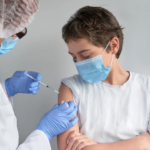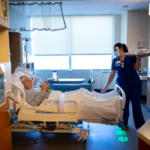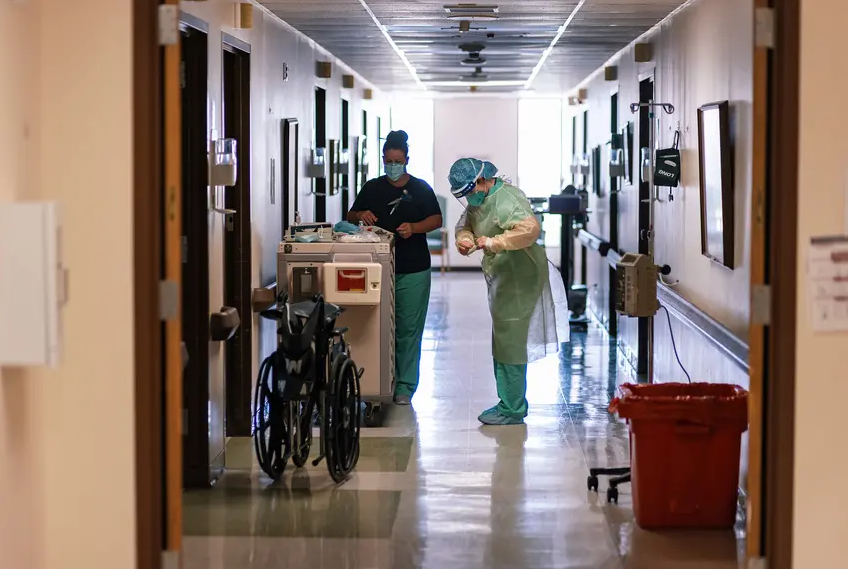Cortney Stout, an emergency room travel nurse, said she would often work 12- to 13-hour shifts during her last assignment in San Antonio, sometimes going the whole day without eating or having time to go to the bathroom. But for most of November, she saw signs that the threat of COVID-19 was easing up around her. The hospital where she worked stopped requiring her to wear an N95 mask and COVID-19 cases seemed to dwindle, giving her and other health care workers a temporary reprieve.
The relief didn’t last for long.
“Just as things seem to get better and (cases) start easing off, it’s just like someone dropped a bomb of (COVID-19), and the next thing you know you have dozens of people coming in throughout the day with COVID again,” Stout, 27, said.
Stout is one of hundreds of thousands of health care workers in Texas reeling from repeated pandemic surges in the span of almost two years. The workforce is now preparing for what comes next as the omicron variant fuels a new wave of COVID-19 cases across the nation.
Although some Texas hospitals are better prepared than they were at the beginning of the pandemic — thanks in part to vaccines becoming more widely available and the gained experience treating COVID-19 patients — staff morale still stands on shaky ground, according to hospital officials in Texas’ largest metro areas and across the state. Hospitals are bracing for not only another surge in COVID-19 cases and hospitalizations, but also for a renewed burden on an already burned-out and depleted workforce.
“We know what (COVID-19) looks like. Certainly it may change a little bit, but we’ve got the script written in terms of how to provide care for COVID patients,” said Carrie Kroll, vice president of advocacy, quality and public health at the Texas Hospital Association. “The issue is just volume and what we’ll see in terms of hospitalizations and whether or not we’ll be able to provide the capacity needed.”
As COVID-19 hospitalizations in Texas have crept up this month to around 3,000, hospital officials say the numbers do not yet mirror the levels seen in the state’s last spike, which was spurred on by the highly contagious delta variant. Dr. Esmaeil Porsa, president and CEO of Harris Health System, a hospital system in Harris County, said about 40 people are currently hospitalized for COVID-19 in his facilities — about double the amount from last week. (The system reached a high of 190 patients hospitalized with COVID-19 during the last surge.)
“In terms of actual numbers it’s manageable, (but) that’s not the concern,” Porsa said of recent hospitalizations. “The concern is the fact that the rate of increase is really ramping up. So there is a very good chance that by the end of this calendar year (or) at the beginning of (the) new year, we may be back in the middle of a huge COVID surge, and that is concerning.”
Porsa and other hospital officials have expressed no doubt that health care workers will work to meet the moment — but the question is whether there will be enough of them to balance hospital demand, especially as more patients not sick with COVID-19 have been coming in to receive delayed care.
Balancing the needs of COVID-19 patients with other medical emergencies has also presented a problem, Stout said.
“There would be days where we had people who were having heart attacks sitting in the waiting room because we didn’t have a bed or room or anywhere to put them,” Stout said.
During the last surge, the number of health workers dispersed throughout the state to help hospitals during COVID-19 spikes reached a high of almost 7,700 in early October, with numbers tapering off the following weeks, according to data from the Texas Department of State Health Services.
Between Dec. 10 and Dec. 16, about 50 Texas hospitals reported that their ICU beds were filled to capacity. The state has been able to supply additional staff through federal disaster funds and coronavirus relief funds, spending almost $7 billion throughout the pandemic on additional personnel, according to DSHS spokesperson Douglas Loveday. In November, the Biden administration announced it would extend 100% federal reimbursements to states for certain COVID-19 emergency response costs through April 1, 2022.
The number of surge health workers across the state has dwindled down to about 400 people as of this week, with most of them concentrated in the El Paso and Panhandle regions, according to DSHS data.
As of Tuesday, the most current data shows omicron still hasn’t become the predominant COVID-19 variant in El Paso, said Dr. Joel Hendryx, treasurer of the El Paso County Medical Society and chief medical officer for University Medical Center in El Paso.
In San Antonio, Dr. Bryan Alsip, chief medical officer for University Health System, said one of the big reassurances the hospital system has is its stockpile of personal protective equipment, which was hard to come by early in the pandemic. Alsip said spirits among the system’s health care workers were high during the early days of the vaccination campaign, but discouragement grew in the fall as cases surged among the unvaccinated.
“That was, I think, a real frustration for health care workers because those (hospitalizations) could have been prevented and certainly patients were taking up beds that could go to other patients who had been delaying care,” Alsip said.
In the Dallas-Fort Worth area, health workers still fatigued from previous surges are starting to see another increase in patients. Stephen Love, president and CEO of Dallas-Fort Worth Hospital Council, said he’s particularly worried that some health care centers in his area won’t be able to receive the same level of temporary staffing they once received earlier in the pandemic.
“Other things we’re trying to do is work to rotate people as much as possible to help ease some of that workload,” Love said. “It’s still an uphill battle. We’re trying to bring in traveling nurses, we’re trying to bring in part-time nurses. Unfortunately, the supply is limited, and unfortunately the cost is astronomical.”
Joyce Batcheller, president-elect of the Texas Nurses Association, said health care workers are no longer able to rely on certain government mitigation efforts — such as a statewide ban on elective surgeries, which Gov. Greg Abbott ended in September last year — to help alleviate the pressure in case omicron unleashes a new wave of hospitalizations. The medical field, and particularly the nursing field, is also going through a reckoning as more people retire, pivot to travel nursing for better pay and more freedom or leave the career field altogether.
“This has just been very taxing, and I think the staffing in the hospitals is going to continue to be challenging as new roles pop up that are outside the four walls of the hospitals,” Batcheller said. “They’re going to be more appealing than constantly taking care of COVID patients and potentially also putting themselves at risk. So we’re not going to be done with (the) shortages that we’ve seen for quite a while.”
This article was originally posted on For Texas hospitals, a new COVID-19 surge looms over a burned-out, depleted workforce











More Stories
Nasal COVID-19 vaccines help the body prepare for infection right where it starts – in your nose and throat
How important is the COVID-19 booster shot for 5-to-11-year-olds? 5 questions answered
Universal masking returns to Philadelphia schools Monday